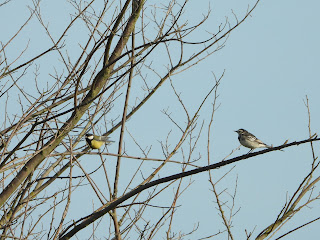Medmerry Trip Report, Guided Birdwatching 13th September 2020
Summer weather had returned but there was no doubt it was autumn with the range of birds found on a guided birdwatching trip at RSPB Medmerry.
Meeting in the car park and what a location this turned out to be! It was shades of the corresponding trip last year, read the trip report here. 16 species were seen in a single dead tree, one of which was a bright yellow wagtail. Another attractive yellow bird in the tree was a male yellowhammer. It was obviously the place to be as the frenzy of avian activity lasted for around half an hour. One moment it was a great spotted woodpecker, then the next if was a great tit, some linnets and goldfinches, up next were a sedge warbler and a chiffchaff, and then a whitethroat… you get the idea!
Great tit and pied wagtail; linnet; yellowhammer; pied wagtail; whitethroat (photos by Les Phillips); and finally, yellow wagtail and sedge warbler
Overhead two different sneezing calls could be heard, one type being made by the yellow wagtails, and the other by a much more unusual bird at Medmerry, siskins. A flock of 8 siskins flew west over the car park and then short while later another 15 headed in the same direction, a definite sign of autumnal movement. This visible, and audible, migration of birds was a theme of the day as swallows and sand martins poured south over the reserve. They seemed to favour a couple of routes through the site, as there were noticeable hotspots of aerial traffic in certain locations. Meadow pipits too were on the move, with them seeping and bouncing around in greater than typical regularity.
Wading birds weren’t numerous but nevertheless diverse in species. They appeared to be dotted around with a few redshank and a curlew in one spot, a bar-tailed godwit and an oystercatcher in another, and a greenshank, two ringed plovers and several lapwing in a third location. In addition to these, a whimbrel could be heard somewhere toward the middle of the site.
A couple of wigeon flying in appeared to have just returned from their travels, owing to their uneasiness in choosing a place to land down. Out in the middle of the reserve an osprey was perched low down in a dead tree, always a favoured choice of seating for this species. It remained perched for the duration of our stay so the ducks and other birds weren’t too alarmed by its presence.
Wheatears, whinchats, stonechats and some robins were all in attendance. These species in the chat family are some of the most obliging around and typically allow themselves to be viewed fairly close by, and unobstructed as they like to perch on a prominent place. The stonechats could all be found in one spot, along with two whinchats in the same location. Generally you will find stonechats in pairs, if a male is seen then chances are there will be a female somewhere close by. But on this day six stonechats were all together.
On the return leg of the outing a spoonbill stood on some bare ground, it appearing as a sleeping white shape. Fortuitously it woke up and we had the opportunity to admire its most unusual bill. This individual was a juvenile bird, and despite the impressive size of its bill it was still not quite at its full length. After several minutes the spoonbill flew off and then in the distance three further spoonbills could also be seen. They fly with their necks straight, unlike a heron or egret that curves its neck back. This makes a spoonbill equally distinctive in flight as on the ground!
 |
| Spoonbill, photos by Les Phillips. |
A great mix of birds had been seen during the outing, with 62 species being noted. If you are interested in attending a guided birdwatching session such as this one, the upcoming events can be seen on the ‘Events’ page of this website. Or to stand the best chance of a space being available, you can get the information emailed to you prior to its publication online by joining my mailing list. To do so simply email me at baggaleyhugh@gmail.com
- Hugh Baggaley










Comments
Post a Comment